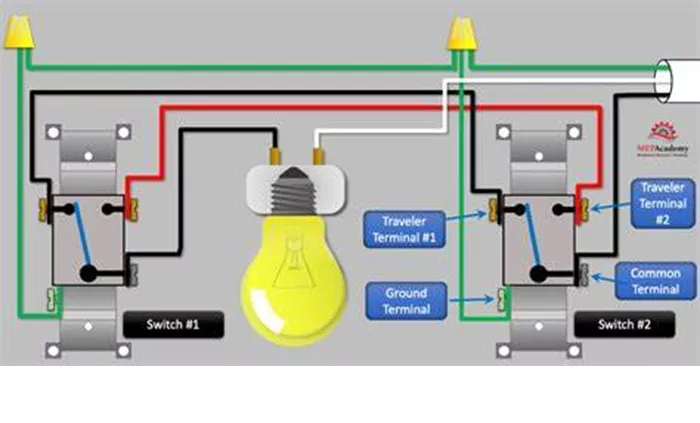When working with electrical wiring, selecting the correct wire for a light switch is crucial for safety and efficiency. As an electrical equipment engineer with expertise in transformers, I understand how wire selection impacts circuit performance, voltage drop, and overall system reliability. This article provides a detailed guide on choosing the right wire for light switches, considering factors such as material, gauge, insulation, and compliance with electrical codes.
Understanding the Basics of Light Switch Wiring
Light switches control the flow of electricity to lighting fixtures, requiring wires that can handle the electrical load without overheating. The wiring must be durable, properly insulated, and sized according to the circuit’s amperage.
Key considerations for light switch wiring
The wire used in light switch installations must meet specific electrical standards to ensure safety and functionality. Factors such as wire material, gauge, insulation type, and environmental conditions all play a role in determining the best choice for a given application.
Types of Wires Used for Light Switches
Different types of wires are suitable for light switch installations, each with unique properties that make them ideal for specific scenarios.
Solid core vs. stranded wire
Solid core wire consists of a single, solid conductor, making it rigid and ideal for permanent installations where minimal movement is expected. Stranded wire, on the other hand, is composed of multiple thin strands twisted together, offering greater flexibility and resistance to fatigue from bending.
Copper vs. aluminum wiring
Copper is the most common material for electrical wiring due to its excellent conductivity and corrosion resistance. Aluminum wiring, while less expensive, has higher resistance and can oxidize over time, leading to potential connection issues.
Choosing the Correct Wire Gauge
The wire gauge determines the current-carrying capacity of the wire. Using an incorrect gauge can lead to overheating, voltage drop, or even fire hazards.
Common wire gauges for light switches
Most residential light switches use 14-gauge or 12-gauge wire, depending on the circuit’s amperage. A 15-amp circuit typically requires 14-gauge wire, while a 20-amp circuit needs 12-gauge wire to handle the higher current safely.
Impact of wire length on gauge selection
Longer wire runs experience greater voltage drop, which may necessitate a thicker gauge to maintain efficiency. For example, a 100-foot run may require 12-gauge wire even for a 15-amp circuit to prevent excessive voltage loss.
Insulation and Safety Standards
Proper insulation is critical to prevent electrical shocks and short circuits. Different insulation types are rated for various environmental conditions.
Thermoplastic vs. thermoset insulation
Thermoplastic insulation, such as PVC, is flexible and resistant to moisture, making it suitable for indoor use. Thermoset insulation, like cross-linked polyethylene (XLPE), offers higher heat resistance and is often used in high-temperature environments.
Color coding for easy identification
Electrical wires follow standardized color codes to simplify installation and troubleshooting. In the U.S., black or red wires typically indicate live (hot) wires, white represents neutral, and green or bare copper is used for grounding.
Compliance with Electrical Codes
Adhering to local electrical codes ensures that wiring installations are safe and legally compliant.
National Electrical Code (NEC) requirements
The NEC specifies minimum wire gauge, insulation ratings, and installation methods for light switches. For example, NEC Article 404 covers switch wiring, requiring proper grounding and box fill calculations to prevent overheating.
Regional variations in wiring standards
Different countries and regions may have unique wiring standards. For instance, European wiring often uses brown for live, blue for neutral, and green/yellow for ground, differing from U.S. color codes.
Transformer Considerations in Switch Wiring
Transformers play a role in certain lighting systems, particularly low-voltage setups like LED lighting or smart switches.
Low-voltage wiring requirements
Systems using transformers for voltage reduction (e.g., 12V or 24V lighting) may require thinner gauge wires compared to standard 120V circuits. However, proper insulation and shielding are still necessary to prevent interference.
Impact of transformer efficiency on wire selection
High-efficiency transformers minimize power loss, but wire resistance can still affect performance. Using appropriately sized wires ensures optimal voltage delivery to the light fixtures.
Installation Best Practices
Proper installation techniques enhance safety and longevity.
Proper stripping and termination
Wires should be stripped to the correct length to ensure secure connections without exposed conductors. Using wire nuts or terminal screws properly prevents loose connections that could lead to arcing.
Avoiding common mistakes
- Overcrowding electrical boxes can cause overheating.
- Using undersized wires increases fire risk.
- Failing to secure wires with staples or clamps may lead to damage over time.
Conclusion
Selecting the right wire for a light switch involves understanding material properties, gauge requirements, insulation types, and compliance with electrical codes. By following best practices and considering transformer-related factors in specialized systems, electricians and DIY enthusiasts can ensure safe and efficient installations. Always consult local regulations and, when in doubt, seek professional guidance to avoid hazards.
This comprehensive guide provides the necessary knowledge to make informed decisions about light switch wiring, ensuring both safety and performance in electrical systems.
Related Topics:

